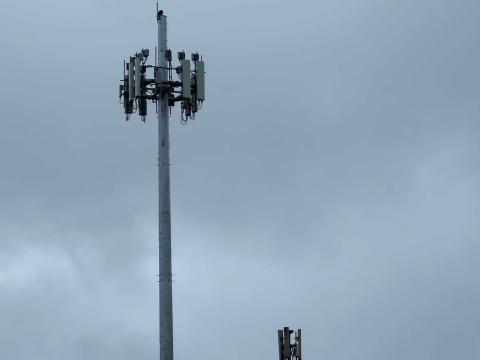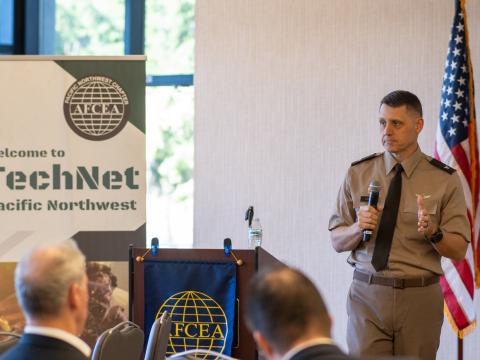Information Systems Get Marching Orders
Enterprise approach fortifies network power.
The U.S. Army’s infostructure is falling into formation under a new command that is responsible for the operation, management and defense of that service’s information systems worldwide. The organization’s mission—provide a high-speed, secure, interoperable knowledge enterprise across the Army and around the globe that plugs into joint systems and the Global Information Grid.
This businesslike approach to network management is warranted for an organization as large as the Army. If viewed in corporate terms, the service has more than 1.2 million full- and part-time employees who work at hundreds of locations worldwide within an estimated fiscal year 2003 budget of $91 billion. Corporations of similar magnitude know the pay-off of adopting an enterprisewide approach to systems management, and now the Army is following suit.
Although the military services are not like a typical company, the Army’s Network Enterprise Technology Command/9th Army Signal Command, or NETCOM, incorporates many of industry’s best practices by organizing its information technology services around its core competencies.
Army leaders are quick to point out that NETCOM, headquartered at Fort Huachuca, Arizona, does not add a layer of bureaucracy to technology management but rather restructures and realigns existing positions to meet current needs efficiently and effectively.
NETCOM’s commander, Maj. Gen. James C. Hylton, USA, explains that the command will focus on the operation and management of the Army’s networks through a technical control relationship that includes developing standards, performance metrics, configuration management and networthiness. NETCOM does not need to own the pieces of the network to manage it at the enterprise level, he adds.
The new command is the information technology piece of the Army’s overall transformation puzzle. Through NETCOM, the Army is centralizing the operation and management of the institutional side of the enterprise infostructure and flattening the organizational construct to remove several layers of hierarchy.
“NETCOM is the result of the transformation of the Army’s IT mission area—a single authority to operate, manage and defend the infostructure at the enterprise level. This is totally different than in the past where every major command; functional proponents like personnel, logistics and intelligence; and components such as the Army National Guard and Reserve built their own systems and networks to accomplish their missions,” Gen. Hylton states.
The command’s work will unify the Army’s efforts in another arena—the joint world. “One thing that has been particularly satisfying to me has been the Army’s focus and its relationship to the joint environment, the GIG [Global Information Grid]. The overarching strategy is to operate the Army’s portion of the GIG for global reach and power projection in what we do today,” the general says. It is the collective capability of the GIG that makes it very powerful, he adds.
Supporting the Army portion of the GIG is important; however, bringing the Army’s numerous information systems under one umbrella also will increase their potency within the service itself, the general maintains. Networking the Army’s combat structure, which includes units as small as three or four soldiers in a combat camera group to brigades with 1,500 troops, extends the reach of the GIG and supports operations in the United States’ national interest. Systems that provide voice, video and data connections can be tailored to support a specific mission requirement, and NETCOM’s primary responsibility is to support this effort, he says.
Chief Information Officer/G-6 Lt. Gen. Peter M. Cuviello, USA, and NETCOM currently are staffing the implementation of an Army-level policy for networthiness. Through this process, NETCOM will exercise technical control of the enterprise infostructure and ensure that all devices, systems and applications are consistent, secure and interoperable with other components of the Army portion of the GIG. This policy also will address legacy applications and systems, and enterprise-level contracts will enhance standardization, architecture compliance and interoperability while reducing costs.
Relying heavily on information systems brings with it certain risks, however. That is why NETCOM’s mission to protect and defend the networks is critically important, the general says, and the command is not facing this challenge alone. Gen. Hylton relates that his staff has and will continue to work with members of the other services, civil agencies and the commercial sector to refine information and network security policies and procedures.
In November, NETCOM and the Army’s Intelligence and Security Command delivered a proposed plan to the service’s senior leaders regarding their responsibilities in defending networks. The plan addresses organizational and procedural issues and will eventually reach the technical level but not immediately, Gen. Hylton shares. The goal of the initial collective agreement is to ensure that organizational issues and priorities are in place to execute the mission of network defense, he adds.
Situational awareness of the military’s infostructure is one component of effective information operations, both in terms of sharing information and defending the networks. Cyberspace is a new dimension that commanders must consider to execute daily operations as well as plan and carry out full-spectrum operations. Prior to establishing NETCOM, network situational awareness was only available in a stovepiped manner. The command provides a one-stop shop for near-real-time information about the Army’s networks and systems.
NETCOM’s mission will be accomplished through the Enterprise Systems Technology Activity (ESTA). The activity is responsible for developing, implementing and enforcing the systems management processes for operation of the consolidated infostructure. In addition, ESTA is the command’s focal point for policy formation as well as operation and management of commandwide Army knowledge management initiatives.
Although NETCOM centralizes responsibility for the Army’s infostructure, regional chief information officers (RCIOs) across the four continental United States (CONUS) regions will be a large part of carrying out the command’s mission. The RCIO organization is subordinate to NETCOM.
The NETCOM RCIO acts as the G-6 to the regional director and supervises the staff of all directorates of information management and information technology organizations in the region. RCIO responsibilities include enforcing command, control, communications, computers and intelligence management policies, standards, architectures, programs, plans and budgets within the region. In addition, the RCIO provides basic services, such as communication and system support, document management and information assurance as well as regional oversight of network operations.
Outside the United States, NETCOM OCONUS Signal organizations will establish an RCIO to support the regional director. A primary focus will be to support the warfighting headquarters in the theater.
NETCOM also will operate and manage the ground-based networks and systems that constitute the Army’s space communications program. Space assets support the service’s requirement for reach-back capabilities and conducting split-based operations. The responsibilities for using space-based assets to control the battlefield will remain with the Space and Missile Defense Command.
NETCOM may resemble a combination of the U.S. Navy’s approach to information technology management through the Navy/Marine Corps Intranet (NMCI) and the Network Warfare Command (SIGNAL, December 2002, page 24), but Army officials point out that differences exist and NETCOM incorporates the best of these two efforts.
Through the NMCI contract, for example, the Navy has outsourced much of its technology operational management. Through NETCOM, the Army, on the other hand, will continue to evolve its management approach of technology that supports the warfighters and Army business practices.
“We are still in the preliminary stage of organizing ourselves to make these kinds of commercial sourcing decisions, and we have not identified any specific IT [information technology] areas for outsourcing at this time. We expect NETCOM to perform ongoing assessments for sourcing strategies in providing IT services that are compatible and support the Army’s ability to operate in a network-centric information environment,” Gen. Hylton explains. Work in this area is expected to take place late in fiscal year 2003 and in 2004, he adds.
Although the ultimate role of outsourcing has not been finalized, today the Army relies heavily on the capabilities the commercial sector offers particularly in technologies that support network situational awareness and efficient and effective processes, the general says.
Applications that develop a network common operational picture are a priority for Gen. Hylton. These capabilities will be critical to how NETCOM prosecutes its network operations mission. In particular, the general is interested in technologies for displaying the status of the network environment. “What are the network issues? How can we assess those issues? What actions can be taken? The answers to these questions will allow us to manage the health of the global network environment,” he says. Additional commercial technologies will help solve problems in a way that is invisible to the user, he adds.
As a result of the realignment of information systems responsibilities, the Army is examining whether it should collapse multiple disparate networks into the Army GIG. To accomplish this task, one Army network architecture would have to be established, an effort that is a top priority for Gen. Cuviello and the Army’s information technology community. This project would centralize management of current networks, reducing the number and locations of network operations centers. The effort is in the planning and coordination stages.
The command also is working with the Installation Management Activity and the Army Contracting Activity. Together, they are coordinating their efforts so NETCOM is not surprised by activity that may affect its ability to deliver information management capabilities. For example, if an individual region was considering a policy that is not in line with policies of the Army’s chief information office, the command would intervene so future problems could be avoided. In the contracting arena, NETCOM would ensure that Army personnel have access to near-term support of current systems.
Gen. Hylton emphasizes that, while technology enhances the Army’s strategic ability, people continue to be the military’s strongest asset. “Technologies give us a tremendous advantage, but it is the people who can react to change that permits us to do what we do today. Our number one priority is taking care of people,” he asserts.
Support from personnel was one of the reasons NETCOM was established expeditiously. “Human nature is an interesting thing. The people could have resisted the change, but the reason we’re as far as we are is that they’ve embraced change. They pushed it far faster than we thought we could,” the general says.
Additional information on the Network Enterprise Technology Command is available on the World Wide Web at www.netcom.army.mil.




Comments